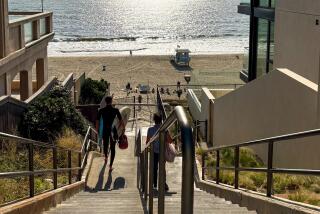A Walk on the Mild Side
- Share via
EASTBOURNE, England — Every guidebook to the trek through the South Downs Way, a glorious path that stretches for 100 miles across Sussex, begins at Beachy Head on the English Channel and proceeds west to end in Winchester, the ancient Saxon capital of England.
But my companion, David, and I decided to tackle the Downs west to east, Winchester to Beachy Head, reckoning that direction would put the wind at our back and hurry us along the way. We’d be walking the reverse of the guidebook we were carrying, Paul Millmore’s “South Downs Way (The National Trail Guide)”--not that we thought we’d make much use of the book or the Landranger maps we’d brought. Britain, after all, is the most widely trampled and sign-posted piece of geography on Earth. Add to that the description of the South Downs Way as a white chalk path and we had the European version of Dorothy’s yellow brick road. What could be easier to follow?
What indeed.
We would begin in late September and take 12 days for our trek, coming down from the Downs each night to sleep at a farmhouse, a bed-and-breakfast, a country inn, even a magnificent castle. No need to lug belongings. We arranged for a taxi to deliver them to our next stop. Civilized place, England.
We had come to England specifically to tramp the South Downs Way, a path made for striding with a minimum of huffing and puffing. It follows the ridges of a chain of chalk-based, grassy hills that shield the land from the sea while forming a backbone for Sussex.
For centuries, the Downs were all grass, unfenced, close cropped by sheep.
Plows didn’t touch the medieval turf of the Downs until World War II, when farmers were called upon to make every square foot of land productive. Fencing replaced shepherds, and crop rotations of hay, corn and, later, rape replaced their sheep. The recent designation of the Downs as an Environmentally Sensitive Area with Outstanding Natural Beauty has encouraged some farmers to return to grazing sheep.
Since the days of the Celts, almost no one has lived on the wind-swept, nearly barren Downs. Villages are in the Weald, the land about 900 feet below, tucked between clumps of woods and fields on the Downs’ northern side. The villages are a steep climb down and up again, something to consider when discussing whether to descend for a warm beer in a dank pub. To the south, the Downs slope gently toward the English Channel with views of the coastal resort cities, such as famed Brighton. These towns have grown from Victorian charm to shameless sprawl, but they’re blessedly distant and blurred in the misty shimmer of light against sea.
We reached Winchester, our trail head, by bus from Heathrow airport. Winchester is a lovely city in which to tarry. It’s compact and laid out for wanderers. Cobbled paths open to hidden gardens edged with ancient walls. Waterways murmur, fed by the lovely streams. Even High Street, despite a proliferation of chain stores, feels like a walk through a previous life. At its head is Great Hall, once William the Conqueror’s castle; along the way are half-timbered houses turned business establishments; and at its end is King Alfred, cast forevermore in bronze. At Winchester’s heart is a grand cathedral, begun in 1079. It claims the longest nave in Britain (hotly contested by Exeter). It is the third cathedral built on the same site. Celebrity tombs are a cathedral specialty, including those of author Jane Austen and of St. Swithin, a 9th century bishop whose name is still revered in Winchester; he was buried in the grounds of the cathedral, as he’d requested. (A century later, monks decided to move his remains inside.)
The Wykeham Arms, tucked in the back streets of the oldest part of the city, welcomed us as it has weary travelers for more than 250 years. It retains its sense of history and identity as a local pub. Before turning in for the night in one of the hostelry’s 16 rooms, all newly redone, we enjoyed a meal that was steps above ordinary pub grub: watercress and potato soup, roast rack of Hampshire Down lamb with root vegetables, and, from the pudding menu, the honey and walnut tart.
The next morning we began our trek under threatening overcast skies. Almost immediately we discovered that it is nearly impossible to follow a guidebook back to front. David noted it first: “The book says to turn left at the hedgerow. We should have turned right way back there!”
And we’d not yet left town.
Book open and interpreting at every turn, we arrived in the countryside an hour later. We were less than one mile from our start at the Wykeham Arms. Now we were standing at the meeting point of several tracks, any of which could be the South Downs Way.
Compass out, Landranger map unfolded. This had become a test in orienteering.
David: “The compass points us that way.”
Me: “Yes, but look here at the map.”
David: “Let’s see what Millmore says.”
What Millmore had to say was this: “The Way is not at all clear at this point. Despite lengthy negotiations, it has not been possible to reach agreement on the permanent route of the South Downs Way.”
Overcast had turned to drizzle. Exton--our next stop, by our best reckoning--was still 12 miles away. Drizzle turned to serious rain, which continued throughout the day.
Blessing Gore-Tex, at dusk we stumbled into Exton. Ahead was the village pub and out front the red phone booth from which we were to telephone Charles Hall, who would fetch us for a bed-and-breakfast stay at his Corhampton Land Farm.
In the mud room, with our host’s border collie running circles of excitement around us, we stripped off soaked boots, socks and jackets.
Tea awaited. Upstairs we settled into a simple bedroom. Down the hall was a deep bathtub with plenty of hot water. Dinner would be at the village pub.
We’d made it through Day 1, backward, on the South Downs Way. Optimistically, with the sun playing peekaboo with the clouds, we set out on Day 2, headed for Buriton 12 miles away.
The South Downs Way won’t satisfy those out for a hiking challenge. Instead, when walkers hit their stride, the path offers an elation that’s akin to flying.
The Downs have seen centuries of human action. My scalp crawled with the sense of being observed as we passed Bronze Age burial mounds hunkered down in grass and scrub. On barren Wilmington Hill near the village of Washington, on Day 5, we viewed the mysterious Long Man, a huge outline scratched into the chalk.
Each day brought at least one descent into the Weald, always to spend the night and sometimes because a picturesque village below beckoned. An almost vertical path took us into Fulking to lunch at the Shepherd & Dog, a pub little changed since the 19th century when 2,600 sheep were counted in the parish of Fulking but only 258 humans. As at pub doors everywhere in the Downs, a sign reminded us: “Walkers welcomed. Remove your muddy boots.”
Swans floating on the River Adur led us into Bramber, where every facade seems draped with hanging flower baskets.
On Day 5 we stood at the edge of the River Arun, the rain running in little waterfalls off the spines of our umbrellas, as we discussed the long history of the burly ladies of Bury, the village across the way, a history that included a well-publicized prizefight between Big Ben and Mendoza, both women, in 1791 and an 18th century all-woman cricket team.
We decided to scratch the visit to Bury--the bridge to it was a long, muddy slosh away--and proceed to Amberley Castle, with its lush gardens and ancient turrets.
The castle has been the centerpiece of Amberley village for more than 900 years. In 1989 it was transformed into a fine country hotel with an outstanding restaurant. We headed through the fields, entered the castle’s walled garden, stepped into the Great Hall to remove our sodden boots, and ascended the grand staircase to our room with its huge fireplace, sumptuous furnishings and bathtub big enough for two. Bliss along the South Downs Way.
Layover day at Lewes, midway in our trek, proved more than a “relaxing change,” as our Millmore guide-in-reverse had suggested. Instead it seemed a town too good to be true, with its flower-filled gardens, Norman priory, magnificent ruin of a castle overlooking six centuries of architectural styles, and abundance of--so that’s what they are!--twittens, or narrow medieval alleys. There we checked into the lovingly renovated Shelleys Hotel, a landmark hostelry with a presence on High Street for nearly 200 years.
One day left on the Way. We stood on a stile, a series of steps that takes one up and over a fence or wall, where we could see the sweep of an estuary shimmering in the morning light.
The Seven Sisters, a series of seven hills with intense ups and downs, promised a dramatic finale. We would trace the edge of 500-foot chalk cliffs that billow like sheets hung out to dry over the English Channel. Below, tides suck and rush, pushing a sea stained milky white with eroding chalk.
With the wind in our face, the Seven Sisters looked magnificent, even in the driving rain. “Well done!” Millmore exulted in the final line of his trail guide. “You have now completed the South Downs Way!” No matter that he was patting on the back those ending up where we’d begun.
Guidebook soaked, maps in tatters, all that remained was to descend into Beachy Head, find our B&B;, and mind the sign by the front door: “Leave Your Muddy Boots Here.” Well done, indeed.
(BEGIN TEXT OF INFOBOX / INFOGRAPHIC)
GUIDEBOOK
Trekking the South Downs Way
Getting there: Nonstop service from LAX to Heathrow is available on American, United, British Airways, Air New Zealand and Virgin Atlantic, and direct service from LAX is available on TWA. Restricted round-trip fares begin at $688. Both ends of the South Downs Way are easily accessible by rail and bus service from London. Rail information can be found on the Web at https://www.railtrack.co.uk, telephone 011-44-20-7557-8000.
Where to stay: Especially welcoming along the route: The Wykeham Arms, 75 Kingsgate St., Winchester SO23 9PE; tel. 011-44-1962-85-3834, fax 011-44-1962-854-411; rates begin at $120. Corhampton Lane Farm, Charles Hall, Corhampton, Hampshire SO32 3NB, tel./fax 011-44-1489-877-506; rates begin at $27. Shelleys Hotel, High Street, Lewes, East Sussex BN7 1XS, tel. 011-44- 1273-472-361, fax 011-44-1273-483-152; rates begin at $240. Riverdale House, David and Elizabeth Brown, Seaford Road, Alfriston, East Sussex BN26 5TR, tel. 011-44-1323-871-038; rates begin at $75. Amberley Castle, Amberley, Near Arundel, West Sussex BN18 9ND; tel. 011-44-1798-831-992, fax 011-44-1798-831-998; rates begin at $215.
Where to eat: Pubs along the way offer ordinary fare. Recommended: the restaurants at the Wykeham Arms and Shelleys Hotel and the Queen’s Room at Amberley Castle. All can be reached at the numbers above.
Guides: Paul Millmore’s “South Downs Way (The National Trail Guide),” Arum Press Ltd., is out of print. But it sometimes can be found in old-book shops or on the Web. Maps you’ll need are Landranger 185, 197, 198 and 199, available at many travel bookstores. For more information: The South Downs Web site https://www.nationaltrails.gov.uk offers information about the trail, including accommodations.
Also: the British Tourist Authority, 551 Fifth Ave., Suite 701, New York, NY 10176-0799; tel. (800) 462-2748, Internet https://www.btausa.com..
More to Read
Sign up for The Wild
We’ll help you find the best places to hike, bike and run, as well as the perfect silent spots for meditation and yoga.
You may occasionally receive promotional content from the Los Angeles Times.






